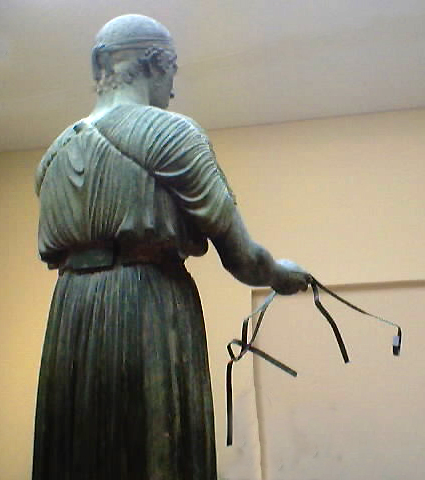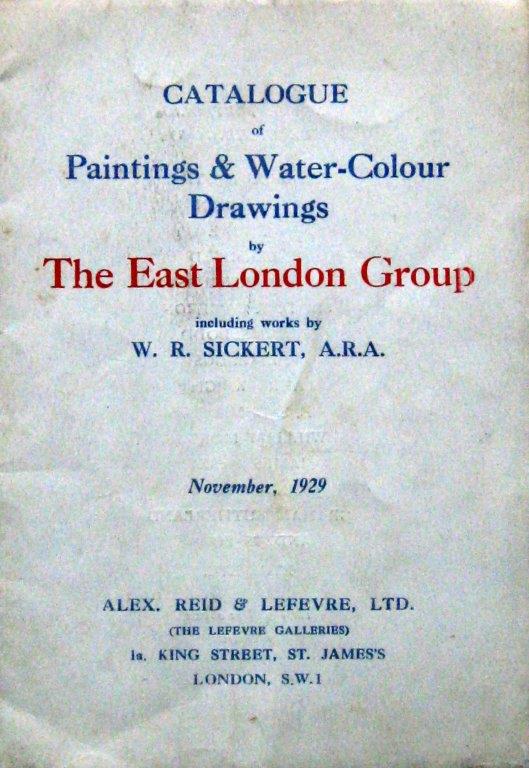|
Mischief And Repose
''Mischief and Repose'' is an 1895 oil-on-canvas painting by British artist John William Godward. It has been held by the J. Paul Getty Museum in Los Angeles since 1979. Godward painted a second, smaller painting, with a different composition but the same title, in 1909. Godward's 1895 painting depicts an interior scene from Ancient Greece or Rome, following the Neoclassical tradition of Lawrence Alma-Tadema. It depicts two auburn-haired young women, both dressed in long flowing robes modelled on an ancient chiton, made of a sheer material, respectively blue and grey, and tied at the waist. For the two female subjects, Godward used his regular models, and . It is signed and dated on the multicoloured marble wall in the upper left corner, "J. W. GODWARD '95". The landscape composition measures . The first woman to the left ("Repose") is lying on a tiger skin spread over a marble bench, with her right hand lifted behind her head and her left arm sprawling outward. To the ri ... [...More Info...] [...Related Items...] OR: [Wikipedia] [Google] [Baidu] |
John William Godward
John William Godward (9 August 1861 – 13 December 1922) was an English painter from the end of the Neo-Classicist era. He was a protégé of Sir Lawrence Alma-Tadema, but his style of painting fell out of favour with the rise of modern art. Early life Godward was born in 1861 and lived in Wilton Grove, Wimbledon. He was born to Sarah Eboral and John Godward (an investment clerk at the Law Life Assurance Society, London). He was the eldest of five children. He was named after his father John and grandfather William. He was christened at St Mary's Church, Battersea on 17 October 1861. The overbearing attitude of his parents made him reclusive and shy later in adulthood. Career He exhibited at the Royal Academy from 1887. When he moved to Italy with one of his models in 1912, his family broke off all contact with him and even cut his image from family pictures. Godward returned to England in 1921, died in 1922, and is buried in Brompton Cemetery, West London. One of h ... [...More Info...] [...Related Items...] OR: [Wikipedia] [Google] [Baidu] |
Neoclassicism
Neoclassicism (also spelled Neo-classicism) was a Western cultural movement in the decorative and visual arts, literature, theatre, music, and architecture that drew inspiration from the art and culture of classical antiquity. Neoclassicism was born in Rome largely thanks to the writings of Johann Joachim Winckelmann, at the time of the rediscovery of Pompeii and Herculaneum, but its popularity spread all over Europe as a generation of European art students finished their Grand Tour and returned from Italy to their home countries with newly rediscovered Greco-Roman ideals. The main Neoclassical movement coincided with the 18th-century Age of Enlightenment, and continued into the early 19th century, laterally competing with Romanticism. In architecture, the style continued throughout the 19th, 20th and up to the 21st century. European Neoclassicism in the visual arts began c. 1760 in opposition to the then-dominant Rococo style. Rococo architecture emphasizes grace, ornamentati ... [...More Info...] [...Related Items...] OR: [Wikipedia] [Google] [Baidu] |
Lawrence Alma-Tadema
Sir Lawrence Alma-Tadema, (; born Lourens Alma Tadema ; 8 January 1836 – 25 June 1912) was a Dutch painter who later settled in the United Kingdom becoming the last officially recognised denizen in 1873. Born in Dronryp, the Netherlands, and trained at the Royal Academy of Antwerp, Belgium, he settled in London, England in 1870 and spent the rest of his life there. A classical-subject painter, he became famous for his depictions of the luxury and decadence of the Roman Empire, with languorous figures set in fabulous marbled interiors or against a backdrop of dazzling blue Mediterranean Sea and sky. Alma-Tadema was considered one of the most popular Victorian painters. Though admired during his lifetime for his draftsmanship and depictions of Classical antiquity, his work fell into disrepute after his death, and only since the 1960s has it been re-evaluated for its importance within nineteenth-century British art. Biography Early life Lourens Alma Tadema was born on 8 ... [...More Info...] [...Related Items...] OR: [Wikipedia] [Google] [Baidu] |
Chiton (costume)
A chiton (Greek: χιτών, ''khitōn'') is a form of tunic that fastens at the shoulder, worn by men and women of ancient Greece and Rome. There are two forms of chiton. One is the Doric chiton and the later Ionic chiton. According to Herodotus, popular legend was that Athenian women began to wear the chiton as opposed to the peplos after several women stabbed a messenger to death with the bronze pins characteristic of the peplos. Etymology The word ''chiton'' is derived from a Central Semitic language *''kittan'' (e.g. Hebrew כֻּתֹּנֶת ''kuttṓnĕṯ''), ultimately from a word for flax. Different forms and wearing styles A shorter version of the chiton was called the chitoniskos. Doric chiton The Doric chiton is a single rectangle of woolen or linen fabric. It can be worn plain or with an overfold called an ''apoptygma'', which is more common to women. It can be draped and fastened at the shoulder by pins (Greek: peronai; Latin: fibulae) or sewing, or by button ... [...More Info...] [...Related Items...] OR: [Wikipedia] [Google] [Baidu] |
Peronai
The peronai (Ancient Greek: περόνη, perónē), also known as perone or porpe, is a straight, long pin used to fasten the outerwear worn by women and men in Ancient Greece. Historically, peronei is also used as a weapon by women in Greek literature.{{Cite book, last=Lee, first=Mireille M., url=https://books.google.com/books?id=dpvWBQAAQBAJ, title=Body, Dress, and Identity in Ancient Greece, date=2015-01-12, publisher=Cambridge University Press, isbn=978-1-107-05536-0, language=en Usage As accessories The visual depiction of peronai shows that the pin is used mostly by women to fasten their peplos. One of the only surviving vases depicting how peronai is used – the François Vase – showed one of the women in the vase, using the peronai where the head of the pin is inserted in between parts of the fabric on her shoulder, with the unprotected part facing upwards. However, descriptions from Ancient Greek literature show that peronai is also used by men. One of these exa ... [...More Info...] [...Related Items...] OR: [Wikipedia] [Google] [Baidu] |
Tessera
A tessera (plural: tesserae, diminutive ''tessella'') is an individual tile, usually formed in the shape of a square, used in creating a mosaic. It is also known as an abaciscus or abaculus. Historical tesserae The oldest known tesserae date to the 3rd millennium BC, discovered in the ancient city of Shahdad in Kerman province, Iran. In early antiquity, mosaics were formed from naturally formed colored pebbles. By roughly 200 BC cut stone tesserae were being used in Hellenistic- Greek mosaics. For instance, a large body of surviving material from the Hellenistic period can be found in the mosaics of Delos, Greece, dating to the late 2nd century BC. Ancient Roman decorative mosaic panels and floor mosaics were also produced during the 2nd century BC, particularly at sites such as Pompeii. Marble or limestone were cut into small cubes and arranged into representational designs and geometric patterns. Later, tesserae were made from colored glass, or clear glass backed w ... [...More Info...] [...Related Items...] OR: [Wikipedia] [Google] [Baidu] |
Lefevre Gallery
The Lefevre Gallery (or The Lefevre Galleries) was an art gallery in London, England, operated by Alex. Reid & Lefevre Ltd. The gallery was opened at 1a, King Street, St James's, in 1926, when rival art dealers Alexander Reid and Ernest Lefevre joined forces. Upon Reid's death in 1928, his son, A J McNeill Reid succeeded him. Lefevre resigned in 1931. In 1950, the gallery relocated to premises at 30, Bruton Street, Mayfair. Among artists whose first British solo exhibitions were hosted by the gallery were Salvador Dalí, Edgar Degas, André Derain, L. S. Lowry, Amedeo Modigliani, Henri Rousseau, Gregorio Prieto and Georges Seurat, It also held the first London exhibitions for Bernard Buffet, Balthus and René Magritte. Others who exhibited there included Francis Bacon, Lucian Freud, Walter Sickert, Wyndham Lewis, and the East London Group. The gallery closed in 2002, citing competition from auction houses, changes in tax on works imported from outside the European Union ... [...More Info...] [...Related Items...] OR: [Wikipedia] [Google] [Baidu] |
Henry Grayson
Lieutenant-Colonel Sir Henry Mulleneux Grayson, 1st Baronet, (26 June 1865 – 27 October 1951) was an English shipbuilder. Early life Grayson was born on 26 June 1865 in Birkenhead and was the son of Henry Holdrege Grayson and Elizabeth (née Mulleneux) Grayson. He was educated at Winchester College and later played first-class cricket for Liverpool and District against Nottinghamshire in 1889 and Yorkshire in 1890, scoring 66 runs at an average of 16.50, with a high score of 42. His brother John was also a first-class cricketer. Career He entered the family shipbuilding and ship-repairing firm, H. & C. Grayson Ltd, which had been founded on the River Mersey in 1760 and of which his father was managing director. He succeeded his father on the latter's death in 1904 and was also managing director of the Garston Graving Dock & Shipbuilding Co Ltd. In 1914 he became a member of the Shipbuilders' Advisory Committee to the Admiralty, and in 1916 was appointed Director of Ship Re ... [...More Info...] [...Related Items...] OR: [Wikipedia] [Google] [Baidu] |
John William Godward - Mischief And Repose, 1909
John is a common English name and surname: * John (given name) * John (surname) John may also refer to: New Testament Works * Gospel of John, a title often shortened to John * First Epistle of John, often shortened to 1 John * Second Epistle of John, often shortened to 2 John * Third Epistle of John, often shortened to 3 John People * John the Baptist (died c. AD 30), regarded as a prophet and the forerunner of Jesus Christ * John the Apostle (lived c. AD 30), one of the twelve apostles of Jesus * John the Evangelist, assigned author of the Fourth Gospel, once identified with the Apostle * John of Patmos, also known as John the Divine or John the Revelator, the author of the Book of Revelation, once identified with the Apostle * John the Presbyter, a figure either identified with or distinguished from the Apostle, the Evangelist and John of Patmos Other people with the given name Religious figures * John, father of Andrew the Apostle and Saint Peter * Pope John ... [...More Info...] [...Related Items...] OR: [Wikipedia] [Google] [Baidu] |
Paintings In The Collection Of The J
Painting is the practice of applying paint, pigment, color or other medium to a solid surface (called the "matrix" or "support"). The medium is commonly applied to the base with a brush, but other implements, such as knives, sponges, and airbrushes, can be used. In art, the term ''painting ''describes both the act and the result of the action (the final work is called "a painting"). The support for paintings includes such surfaces as walls, paper, canvas, wood, glass, lacquer, pottery, leaf, copper and concrete, and the painting may incorporate multiple other materials, including sand, clay, paper, plaster, gold leaf, and even whole objects. Painting is an important form in the visual arts, bringing in elements such as drawing, Composition (visual arts), composition, gesture (as in gestural painting), narrative, narration (as in narrative art), and abstraction (as in abstract art). Paintings can be naturalistic and representational (as in still life and landscape art, lands ... [...More Info...] [...Related Items...] OR: [Wikipedia] [Google] [Baidu] |







